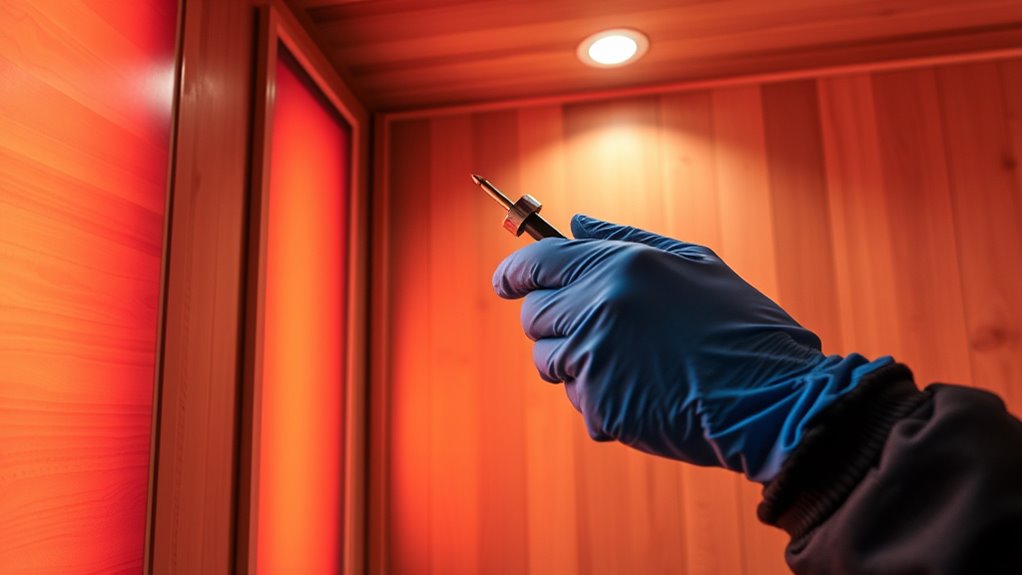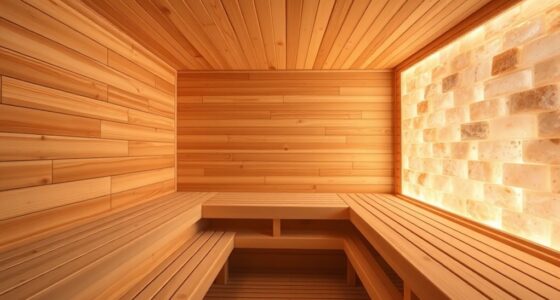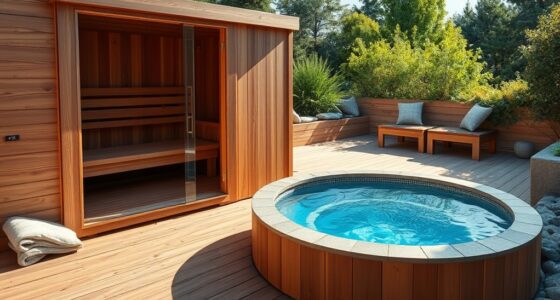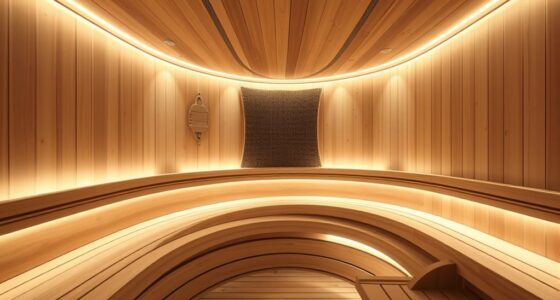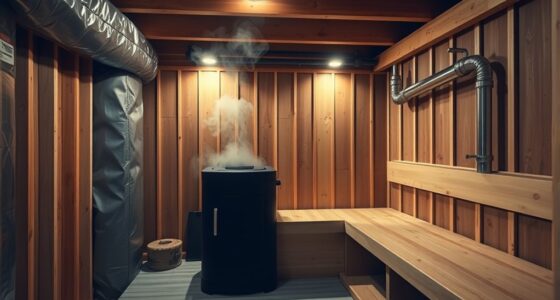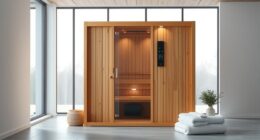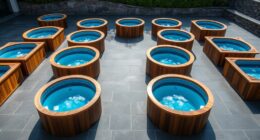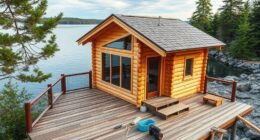To install infrared panels in your home sauna, start by planning the layout to ensure even heat distribution, placing panels at eye level or slightly above on the walls. Make sure to use a dedicated circuit and have a qualified electrician handle the wiring for safety. Properly secure the panels to wall studs or suitable surfaces, leaving enough clearance for airflow and safety. For a smooth setup and ideal performance, following detailed manufacturer instructions is key—keep going to learn all the essential tips.
Key Takeaways
- Determine optimal panel placement on walls for even heat distribution and user comfort.
- Ensure proper electrical wiring by hiring qualified electricians and using dedicated circuits.
- Follow manufacturer installation instructions carefully, using appropriate mounting brackets and secure attachment.
- Maintain proper clearance around panels to prevent overheating and ensure safety.
- Incorporate ventilation planning to improve sauna performance and prolong panel lifespan.
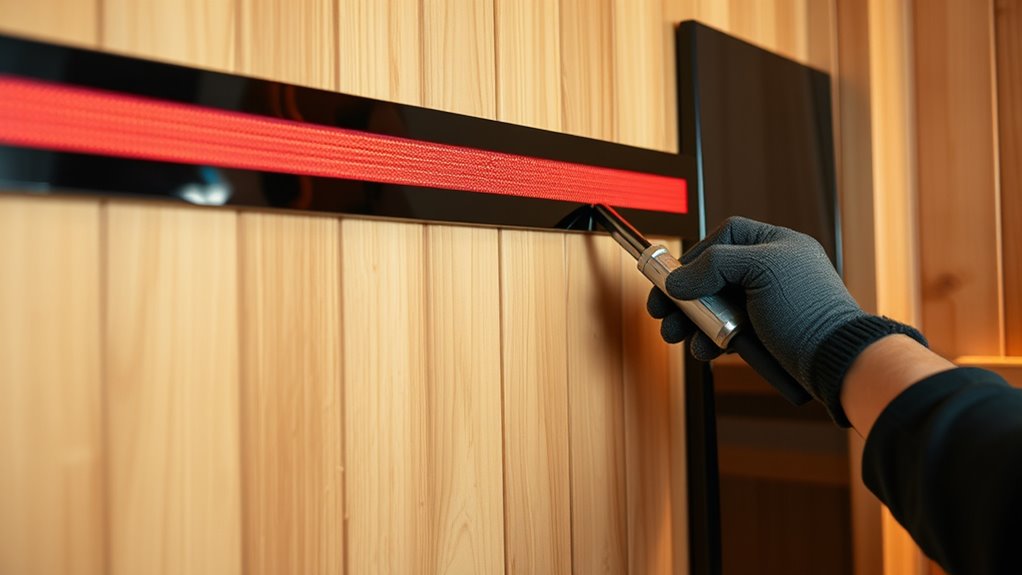
Infrared panels have become a popular choice for home saunas because they offer an efficient and comfortable way to enjoy the benefits of heat therapy. They emit infrared radiation that penetrates your skin directly, providing deep relaxation, pain relief, improved circulation, and detoxification. Unlike traditional saunas, which heat the air around you, infrared panels warm your body directly, making your sauna experience more comfortable and energy-efficient.
When contemplating installing infrared panels, understanding the benefits of infrared can help you make an informed decision. These panels heat your body at lower temperatures, typically between 120-140°F, reducing the risk of overheating while still delivering therapeutic heat. This means you can enjoy longer sessions without feeling overwhelmed by heat, making it suitable for most users. Additionally, infrared heat can help ease muscle tension, improve skin health, and boost your immune system, all from a comfortable, seated position. Installing infrared panels is also more straightforward compared to traditional sauna heaters, and they tend to consume less energy, which can save you money over time.
Before you start panel installation, it’s vital to plan your sauna’s layout carefully. First, determine the size of your space and how many panels you’ll need to achieve even heat distribution. Typically, a well-sized infrared sauna uses multiple panels spaced evenly on the walls, avoiding overcrowding or uneven heating. Make sure the panels are installed at the right height—usually eye level or slightly above—to maximize their effectiveness. It’s also important to consider ventilation and electrical requirements; infrared panels need a dedicated circuit, and your space should have proper airflow to prevent overheating. Incorporating knowledge about lifestyle adaptations can help you optimize your sauna experience and maintenance routine.
When installing the panels, follow the manufacturer’s instructions closely. Use appropriate mounting brackets and ensure the panels are securely attached to the wall studs or suitable mounting surfaces. Keep safety in mind by maintaining clearance around the panels, especially near water sources or humid areas. Wiring should be handled by a qualified electrician who understands local codes, guaranteeing the installation is safe and compliant. Proper placement is key—avoid placing panels directly over seating areas or where they might be obstructed, as this can reduce their efficiency.
Frequently Asked Questions
What Safety Precautions Should I Follow During Installation?
You should turn off the power before starting installation and carefully handle electrical wiring to prevent shocks. Always wear personal protective equipment like gloves and safety glasses to avoid injuries. Follow the manufacturer’s instructions closely, ensuring all connections are secure. Use proper tools and double-check that the power is off before working on the panels. These precautions help keep you safe during the infrared panel installation process.
Can Infrared Panels Be Used With Existing Sauna Heaters?
Yes, infrared panels can be used with existing sauna heaters if they’re infrared compatible and designed for heater integration. You need to confirm the panels are compatible with your current system’s specifications and that they won’t interfere with heating functions. It’s best to consult a professional to verify proper integration, as improper setup might cause safety issues or reduce efficiency. Proper compatibility checks ensure seamless and safe operation.
How Do I Troubleshoot if Panels Are Not Heating Properly?
If your infrared panels aren’t heating properly, start with infrared panel troubleshooting by checking the power supply and ensuring connections are secure. Look for any visible damage or loose wiring. Test the circuit breaker to confirm it’s not tripped. If these steps don’t resolve the heating issues, consult the manufacturer’s guidelines or contact a professional technician. Regular maintenance and inspection help prevent common infrared panel heating problems.
Are There Specific Insulation Requirements for Infrared Panel Installation?
In the blink of an eye, you need to follow insulation standards to guarantee safety. You should install thermal barriers around the infrared panels to prevent heat loss and protect surrounding structures. Use fire-resistant insulation materials and maintain proper clearance from combustible surfaces. Adequate insulation not only improves efficiency but also ensures the panels operate safely, reducing the risk of overheating and potential hazards in your sauna.
What Is the Typical Lifespan of Infrared Sauna Panels?
You can expect infrared sauna panels to last about 10 to 20 years, depending on factors like usage, quality, and maintenance. Infrared panel durability varies, but proper care and avoiding excessive heat or moisture extend their lifespan. Panel lifespan factors such as voltage, insulation, and frequency of use influence how long they remain effective. Regular inspections and cleaning help maximize their longevity, ensuring you enjoy consistent, safe infrared heat for years to come.
Conclusion
As you step into your sauna, feel the gentle warmth of the infrared panels wrapping around you like a comforting embrace. The heat seeps deep into your muscles, melting away tension and bringing a sense of calm. With each session, you create a sanctuary of relaxation, where the soft glow of the panels reminds you that true peace begins from within. Embrace this warmth, and let it transform your mind and body, one soothing moment at a time.
